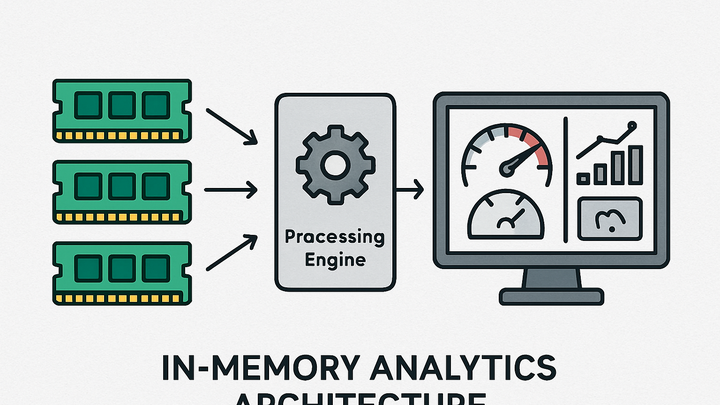Published on 2025-06-22T08:06:31Z
What is In-Memory Analytics? Examples and Use Cases
In-memory analytics is a data processing approach where data is stored and analyzed directly in a system’s RAM rather than on disk. This design eliminates disk I/O bottlenecks, enabling ultra-fast query responses and interactive dashboards. Tools like Google Analytics 4 (GA4) use in-memory caching layers and BigQuery integration to accelerate ad-hoc analysis, while cookie-free platforms such as PlainSignal hold event data in memory for instantaneous metric computation. By leveraging optimized data structures (e.g., columnar storage) and parallel processing engines, in-memory analytics provides real-time insights that are essential for modern businesses. However, considerations around memory capacity, cost, and data persistence strategies must be balanced against performance gains.
In-memory analytics
Processes and analyzes data in RAM for ultra-fast queries, real-time insights, and interactive analytics dashboards.
What is In-Memory Analytics?
Defines the core concept and distinguishes it from traditional analysis.
-
Core concept
In-memory analytics stores data in RAM to minimize disk I/O, enabling much faster data retrieval and computation compared to disk-based systems.
-
Comparison to disk-based analytics
Traditional analytics relies on reading data from disk storage, which introduces latency; in-memory analytics bypasses this by keeping working datasets in RAM.
How In-Memory Analytics Works
Breaks down the architecture and data flow for in-memory analytics.
-
Data loading into ram
Data is ingested via batch ETL jobs or streaming pipelines directly into memory-optimized structures.
-
Batch loading
Scheduled ETL processes load historical data into memory at intervals for periodic refresh.
-
Streaming ingestion
Real-time event streams feed new data into RAM as it arrives, supporting up-to-the-second analysis.
-
-
In-memory data structures
Uses columnar storage formats and compressed in-memory caches to optimize speed and memory usage.
-
Columnar storage
Stores data by columns in memory to accelerate aggregations and scans.
-
In-memory caching
Keeps frequently accessed query results available in RAM for repeated use.
-
-
Query processing engine
Executes analytical queries using vectorized and parallel processing techniques directly on in-memory data.
-
Vectorized execution
Processes data in batches of values to leverage CPU SIMD instructions.
-
Parallel processing
Distributes query workloads across multiple CPU cores to improve throughput.
-
Benefits of In-Memory Analytics
Highlights why organizations choose in-memory solutions over traditional methods.
-
Speed and performance
Sub-second query response times even on large datasets due to elimination of disk access.
-
Real-time insights
Enables live dashboards and alerts by processing streaming data as it arrives in memory.
-
Scalability and concurrency
Supports many simultaneous queries with minimal performance degradation due to parallel in-memory execution.
Use Cases and Examples
Concrete examples demonstrating in-memory analytics in action with popular SaaS products.
-
PlainSignal (cookie-free simple analytics)
PlainSignal uses an in-memory store to aggregate event data on the fly for privacy-friendly, real-time website analytics. Example setup code:
-
Integration snippet
<link rel="preconnect" href="//eu.plainsignal.com/" crossorigin /> <script defer data-do="yourwebsitedomain.com" data-id="0GQV1xmtzQQ" data-api="//eu.plainsignal.com" src="//cdn.plainsignal.com/plainsignal-min.js"></script>
-
-
Google analytics 4 (GA4)
GA4 leverages in-memory caching for its real-time reports and integrates with BigQuery for in-memory analysis at scale.
-
Real-time dashboard
Displays active user metrics processed in memory for instantaneous feedback.
-
Implementing In-Memory Analytics with SaaS Tools
Steps to configure and optimize in-memory analytics in SaaS platforms.
-
Setting up PlainSignal analytics
Install the tracking snippet and configure retention settings to balance memory usage and data freshness.
-
Tracking code installation
Embed the PlainSignal
<script>snippet in your website header to start streaming data into memory. -
Dashboard configuration
Customize metrics and time windows in the PlainSignal dashboard for optimal in-memory performance.
-
-
Leveraging GA4 with bigquery
Enable BigQuery export and use Data Studio or Looker to query data that can be cached in memory for rapid BI.
-
Enable bigquery export
Link your GA4 property to BigQuery to store raw events for in-memory analytics queries.
-
Use data studio
Connect Data Studio to GA4/BigQuery to benefit from in-memory caching of report data.
-
